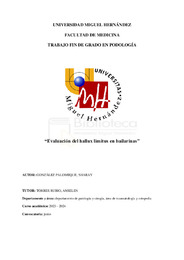Please use this identifier to cite or link to this item:
https://hdl.handle.net/11000/33288Full metadata record
| DC Field | Value | Language |
|---|---|---|
| dc.contributor.advisor | Torres Rubio, Anselen | - |
| dc.contributor.author | González Palomeque, Sharay | - |
| dc.contributor.other | Departamentos de la UMH::Patología y Cirugía | es_ES |
| dc.date.accessioned | 2024-09-25T11:39:57Z | - |
| dc.date.available | 2024-09-25T11:39:57Z | - |
| dc.date.created | 2024-05-31 | - |
| dc.identifier.uri | https://hdl.handle.net/11000/33288 | - |
| dc.description.abstract | Introducción: la danza es una actividad física que requiere flexibilidad, coordinación, equilibrio, agilidad y fuerza muscular. En esta disciplina se realizan posiciones del pie “anormales” que pueden llegar a provocar lesiones. La primera articulación metatarsofalángica es importante a la hora de realizar la marcha, por lo que este deporte requiere de un buen funcionamiento de esta. Objetivos: determinar la incidencia de hallux limitus en bailarinas. Métodos: se ha realizado un cálculo muestral en el que se ha obtenido que se necesitan 30 sujetos. La toma de muestra consistió en realizarles preguntas relacionadas con los entrenamientos y con las lesiones. Además de medir con goniómetro la dorsiflexión de ambos hallux, Test de Jack y realizarles el Foot Posture Index (FPI). Resultados: Tras realizar el test de Kolmogórov-Smirnov y Shapiro Wilk las únicas variables que siguen una distribución normal son: FD carga PD, grado FD descarga PD, grado FD descarga PI. Las bailarinas que no presentaban HL tenían un FPI mayor. Conclusiones: Los datos muestran que la presencia de Hallux Limitus (HL) puede tener un impacto significativo en el FPI. | es_ES |
| dc.description.abstract | Introduction: Dance is a physical activity that requires flexibility, coordination, balance, agility, and muscular strength. In this discipline, "abnormal" foot positions are performed, which can lead to injuries. The first metatarsophalangeal joint is important for walking, but this sport requires it to function well. Objectives: To determine the incidence of hallux limitus in dancers. Methods: A sample calculation has been carried out in which it has been obtained that 30 subjects are needed. The sample collection involved asking questions related to training, and injuries. Additionally, the dorsiflexion of both hallux was measured with a goniometer, the Jack's Test was performed, and the Foot Posture Index (FPI) was assessed. Results: After performing the Kolmogorov-Smirnov and Shapiro-Wilk tests, the only variables that followed a normal distribution were: DF dorsal load FR, degree DF unload RF, degree DF unload LF The dancers who did not present HL had a higher FPI. Conclusions: The data show that the presence of Hallux Limitus (HL) can have a significant impact on the FPI. | es_ES |
| dc.format | application/pdf | es_ES |
| dc.format.extent | 38 | es_ES |
| dc.language.iso | spa | es_ES |
| dc.publisher | Universidad Miguel Hernández | es_ES |
| dc.rights | info:eu-repo/semantics/openAccess | es_ES |
| dc.rights | Attribution-NonCommercial-NoDerivatives 4.0 Internacional | * |
| dc.rights.uri | http://creativecommons.org/licenses/by-nc-nd/4.0/ | * |
| dc.subject | baile | es_ES |
| dc.subject | lesiones | es_ES |
| dc.subject | pie | es_ES |
| dc.subject | hallux limitus | es_ES |
| dc.subject | examen físico | es_ES |
| dc.subject.other | CDU::6 - Ciencias aplicadas | es_ES |
| dc.title | Evaluación del hallux limitus en bailarinas | es_ES |
| dc.type | info:eu-repo/semantics/bachelorThesis | es_ES |

View/Open:
Sharay González Palomeque.pdf
1,07 MB
Adobe PDF
Share:
.png)
